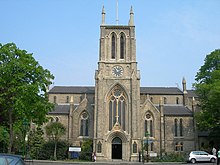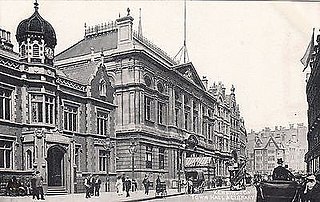
The Metropolitan Borough of Kensington was a metropolitan borough in the County of London from 1900 to 1965, which since 1901 was known as the Royal Borough of Kensington, following the death of Queen Victoria, in accordance with her wishes.

St John at Hackney is a Grade II* listed Anglican Church in the heart of the London Borough of Hackney with a large capacity of around 2,000. It was built in 1792 to replace Hackney's medieval parish church, of which St Augustine's Tower remains, at the edge of its churchyard. The church faces north towards Clapton Square, with the nearby Sutton House and Hackney Central station also accessible from the churchyard to the east and south, respectively. As well as a thriving parish church, St John at Hackney has also become known as a notable music venue, playing host to the likes of Coldplay, Ed Sheeran, Emeli Sande, Robbie Williams, Griff and Interpol.
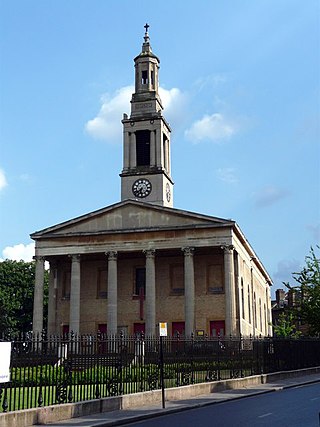
St Luke's Church in West Norwood is an Anglican church that worships in a Grade II* listed building. It stands on a prominent triangular site at the south end of Norwood Road, where the highway forks to become Knights Hill and Norwood High Street.
Lewis Vulliamy was an English architect descended from the Vulliamy family of clockmakers.

The Royal Crescent is a Grade II* listed street in Holland Park, west London, England, consisting of two curved facing terraces in a crescent shape. The crescent is located on the north side of Holland Park Avenue, west of Addison Avenue, and to the east of the Holland Park Roundabout. St Ann's Villas leads north off the Crescent.

St Paul's Church, Salisbury, England, is the Church of England parish church for Fisherton Anger, serving part of the northern suburbs of the city. It was consecrated in 1853 and lies north-west of the city centre, near the railway station. The congregation is affiliated to the Evangelical Alliance. The church is a Grade II listed building.

St Peter's Notting Hill is a Victorian Anglican church in Kensington Park Road, Notting Hill, London. Designed in the classical style by architect Thomas Allom, work was begun in 1855 and completed in 1857.

Addison Road is a road in London, England, which connects Kensington High Street with Notting Hill and Holland Park Avenue, and runs nearby to Holland Park.

Addison Avenue is a street in the Notting Hill area of London. Located in the Royal Borough of Kensington and Chelsea, it runs northwards from Holland Park Avenue to St James's Gardens and St James' Church, crossing Queensdale Road about halfway along. Norland Square is located to its east while Royal Crescent is a little way to the west. A broad, tree-lined avenue, it is largely residential with some commercial properties at the southern end. The smaller Addison Place mews street runs off the western side of the road, looping northwards until it meets Queensdale Road. Addison Avenue is in the wealthy London area of Holland Park.
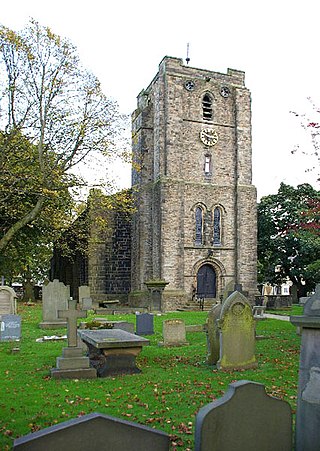
St John the Evangelist's Church is in Church Square in the village of Worsthorne, Lancashire, England. It is an active Anglican parish church in the deanery of Burnley, the archdeaconry of Burnley, and the diocese of Blackburn. The church is recorded in the National Heritage List for England as a designated Grade II listed building.

Our Lady of Victories, in Kensington, London, is a Roman Catholic church. The original church opened in 1869, and for 34 years to 1903 served as pro-cathedral of the Archdiocese of Westminster. That building was destroyed by bombing in 1940: its successor, which survives, opened in 1959. The church stands at 235a Kensington High Street, Kensington, in the Royal Borough of Kensington and Chelsea.

The Parish Church of St Luke, Chelsea, is an Anglican church, on Sydney Street, Chelsea, London SW3, just off the King's Road. Ecclesiastically it is in the Deanery of Chelsea, part of the Diocese of London. It was designed by James Savage in 1819 and is of architectural significance as one of the earliest Gothic Revival churches in London, perhaps the earliest to be a complete new construction. St Luke's is one of the first group of Commissioners' churches, having received a grant of £8,333 towards its construction with money voted by Parliament as a result of the Church Building Act of 1818. The church is recorded in the National Heritage List for England as a designated Grade I listed building. The gardens of St Luke's are Grade II listed on the Register of Historic Parks and Gardens.

The Russian Orthodox Cathedral of the Dormition of the Mother of God and All Saints is the cathedral of the Russian Orthodox Diocese of Sourozh.

Matthew Edward Habershon, known as Edward Habershon, was an architect practising in London and south-east England. He specialised in neo-gothic buildings, especially churches and chapels. With his brother W.G. Habershon he designed St John the Baptist's Church, Hove, now a Grade II building. With E.P.L. Brock he designed a number of churches including St Leonards-on-Sea Congregational Church, also listed at Grade II. He designed St Andrews church in Hastings, where Robert Tressell's large mural was created. In 1862 he was involved in the relocation of London's burial grounds, moving more than one thousand hundredweight of human remains.

Holy Trinity Church is in Accrington Road, Burnley, Lancashire, England. It is a redundant Anglican parish church, and is recorded in the National Heritage List for England as a designated Grade II listed building. Holy Trinity is a Commissioners' church designed by Lewis Vulliamy in Early English style. The church was extended in 1871–72, but closed in 1990, and has been converted into flats.
Robert Jewell Withers (1824–1894) was an English ecclesiastical architect.
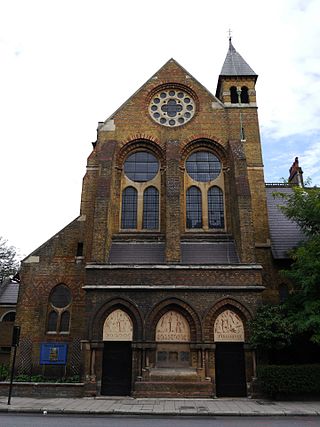
St Peter's, Vauxhall, is a Church of England church on Kennington Lane, Vauxhall, London SE11.
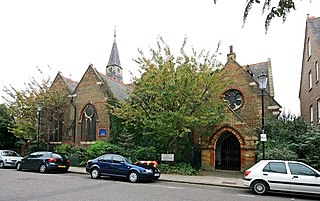
St Clement's Church is a Church of England parish church in Notting Hill, Royal Borough of Kensington and Chelsea, London. The church is a grade II listed building.

Norland Square is a garden square in the Notting Hill area of London. Located in the Royal Borough of Kensington and Chelsea, runs northward from Holland Park Avenue to Queensdale Road. The mews street Norland Place runs eastwards of the Square.
